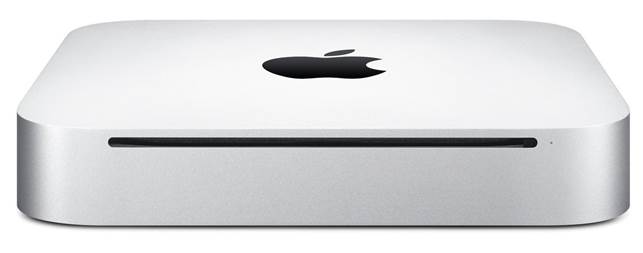Unfairly regarded as the least exciting Mac, the mini hasn’t
been updated in more than a year. But this little machine is by far the
cheapest Mac you can buy and the ideal choice if you want to bring your own
monitor or connect it to your living room TV.
Features
You wouldn’t be far wrong in describing the Mac mini as a 21.5in
iMac without the screen. The iMac has been updated more recently, giving it a
more efficient architecture; but compared to the iMac, the mini was ahead of
its time when it originally appeared, being the first Mac to introduce the
Fusion Drive. And it still beats the iMac with its legacy Firewire 800 port,
handy if you have peripherals lying around that can use it, and HDMI, enabling
you to connect an H DTV set directly. The mini supports one monitor via
Thunderbolt (which, remember, is DisplayPort for monitor purposes; the
connector is physically the same as Mini DisplayPort) at up to 2560 X 1600 plus
one via HDMI at up to 1920 X 1080.

At 19.7cm square and 3.6cm deep, the mini is a
beautifully proportioned little slab that'll fit comfortably almost anywhere,
whether for work or entertainment
You can alternatively connect an HDMI monitor using a Thunderbolt
adaptor, but some users have reported identical HDMI monitors connected to the
two interfaces show different colour balance.
The Mac mini runs very quietly, so it won’t distract you while
watching TV. If you’re buying for home entertainment, bear in mind that there’s
no DVD or Blu-ray drive, and Apple doesn’t support Blu-ray at all, so you’d
need third-party hardware and software, not such a neat solution if you need
disc playback.
Pros and cons
One reason to buy a Mac mini is price: you can add a low-cost
third-party monitor and get a complete system for less than the $1,895.28 cost
of a base 21.5in iMac. A decent-quality 24in screen such as the Dell Ultrasharp
can be found for less than $412.38, making under $1,237.13 in total with a
basic $823.10 Mac mini. Let’s not get carried away, though: that mini has a
slower processor and GPU than the iMac, half the RAM (at a meagre 4GB), and
fewer options to increase the specification when you order. The next model up,
at a still modest $1,120.01, beats the Mac with a Core i7 CPU, but can't match
its Intel Iris Pro graphics.

The mini's single Thunderbolt port will
normally be occupied by your monitor, but if you have Thunderbolt peripherals
with pass-through, you can add the monitor at the end of the chain. There are 4
USB 3 ports, FireWire 800, Gigabit Ethernet, etc.
Flexibility is another reason to pick the mini. Sometimes you
simply need a machine to connect to an existing display, perhaps an HDTV or
projector.
Performance
All minis rely on the Intel HD 4000 graphics processor, the
weakest among current Macs. It struggles to run recent 3D games at high
quality, managing a median of 35.8fps in Batman: Arkham City even at 720p, with
all settings on their default. Raising the settings, this drops to 24.4fps - so
don’t expect to run games at high quality. The mini is thus also a poor choice
for complex motion graphics and scene rendering work.

Uniquely, the base of the mini simply unscrew
like a sweetie jar to reveal the RAM modules. Getting at other component is
trickier, but feasible, for example to replace the hard disk. The server model
crams in two drives
For general tasks, however, it’s fine. The default Core is
processors are capable, and the i7 upgrade option offers a good boost for
demanding tasks such as HD video encoding the 2.5in hard disk feels slow, but
as with the Mac, the $263.92 Fusion Drive is well worth considering to make
everything more responsive. Unfortunately, this isn’t an option with the
$823.10 model, so you’d need to upgrade from the $1,120.01 i7 configuration,
with a sensible 8GB RAM, this starts to look expensive at $1,515.89.